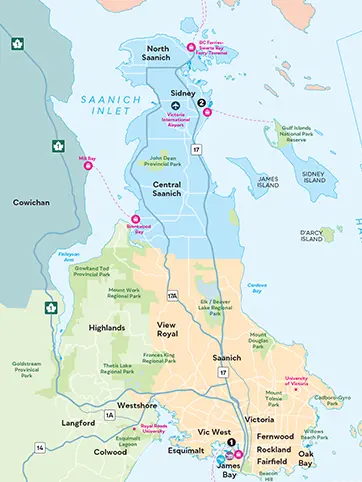
About Greater Victoria and its Visitor Economy

Greater Victoria
The present-day region of Greater Victoria has been inhabited by Coast Salish peoples for thousands of years. European contact with these peoples in the area was established through Spanish - and later British - exploration in the 1790s. In 1843, the Hudson’s Bay Company erected Fort Victoria as a fur trading posting and formed commercial relationships with these local First Nations. Demolished in 1864 as the surrounding population grew, the fort occupied the present-day site of downtown Victoria. The fort, city and region are named for Queen Victoria, who was the reigning British monarch when the fort was built.
Our story

Awards & accolades
Don't just take our word for it. Victoria is well known as a top travel and tourism destination—and for being all-around awesome in so many interesting ways. Click to check out some recent awards.
Learn More
Get to know us

The Greater Victoria visitor economy has a long and storied history. Its origins can be traced to 1861 when the British Columbia House of Assembly provided £500 “for diffusing information about Vancouver Island.” Organized destination marketing in Greater Victoria has existed in various forms since 1901, when the first meeting to create a local tourism association was held.
Destination Greater Victoria was established in 1985. It brought together disparate groups that ran the gamut from accommodation and transportation providers to restaurants and entertainment, retail, and local government – to market Greater Victoria in a coordinated, cohesive, and intelligent manner. The structure of Destination Greater Victoria’s board remains largely intact from its establishment, with broad interests represented in its governance. Today, Destination Greater Victoria is the official not-for-profit destination marketing and management organization in Greater Victoria, with almost 1,000 members in the private, public, and not-for-profit sectors. These members represent an eclectic mix of partners working together to promote, advance and steward the Greater Victoria visitor economy.
For decades regional, provincial, national, and international visitors have flocked to Greater Victoria. But over the years the appeal of Greater Victoria has changed as the destination has evolved. Many attractions and accommodations remain from previous years, such as The Butchart Gardens, Chinatown, British Columbia Parliament Buildings and The Fairmont Empress to name a few. Visitors came to experience Greater Victoria’s English image and relaxing atmosphere. As a coastal city, Greater Victoria’s location on the Pacific Ocean was always a fundamental marketing element. However, Greater Victoria’s tourism product offering has grown and become more diverse. Victoria has more restaurants per person than any other city in Canada. Local First Nations are creating new visitor experiences and telling their stories. The Victoria Conference Centre is a popular facility to hold a meeting, event, or conference and major sporting events now bring thousands of athletes, coaches, and volunteers to Greater Victoria every year.
The visitor economy is the second largest industry in Greater Victoria – employing thousands of people and generating billions in economic impact. From its early, uneven days in the 19th Century to its position as a stalwart of the community today, the Greater Victoria visitor economy has – and will continue to be – part of Greater Victoria’s identity. We welcome the world with open arms to our warm and hospitable destination.
Living in Victoria
Victoria combines job opportunities, accessibility, and a high quality of life with a stunning natural environment, warm summers, and mild winters—a city where people worldwide feel at home. Here, you’ll also find essential resources on real estate and education to help you settle in with ease.
Learn more










